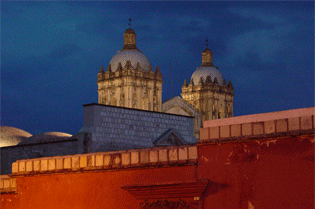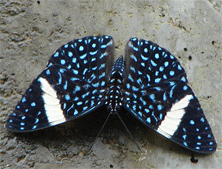

With its diverse package of indigenous culture and endemic butterflies, Oaxaca artfully beckons to all those who love beauty in its many manifestations. Whether it is visiting the impressive ancient Mayan ruins of Monte Alban; finding high quality textiles that are made by hand – using colorful, distinctive, and hand-dyed, cotton and wool – and that are incredibly inexpensive; or feasting on Oaxacan cloud forest and pine forest endemics such as Oaxacan Swallowtail, Cloud-forest Crescent, Oaxacan Pine-Satyr…this is a trip you will long remember. Approximately 1000 species of butterflies have been found in the state of Oaxaca, and the Sierra de Juarez, a few hours east of Oaxaca, is a major center of endemism. More species have been recorded from November than from any other month. We have seen as many as 350 species on this trip. A special feature of this trip is that on at least two of our nights in Oaxaca City we will savor dinners at the most outstanding restaurants in Oaxaca.
Day 1. Saturday. The tour begins this evening at the Oaxaca airport, in the Mexican state of Oaxaca. We will spend this night, and our other nights in Oaxaca City, at a very comfortable hotel in the historic district, within easy walking distance of the central zocolo and its many attractions. Night in Oaxaca.
Day 2. Sunday. This morning we will drive through thorn scrub habitat surrounding Oaxaca and then climb high into pine-oak forest to about 9,000 ft. If we are lucky, a good variety of butterflies will be puddling at a stream that crosses the road. Species that have been here in the past include Mexican Dartwhites (Catasticta nimbice); large Skipperish Tanmarks (Emesis saturata), resembling large spread-wing skippers when they bomb in for a landing; Red-spotted and Guatemalan (Chlosyne erodyle) Patches; gaudily attired Orange-striped Eighty-eights (Diaethria pandama); and Banded Mapwings (Hypanartia dione). Actually, some of the most sensational “butterflies” at this spot are moths, but that’s a different story. Above the stream we have excellent chances of finding higher elevation specialties, such as Mexican Pine-Satyrs (Paramacera xiacaque) and Snowball Skippers (Paratrytone aphractoia). Large and striking pine forest specialties, Black-pointed Tile-Whites (Hesperocharis graphites) may be flying, but we’ll be very fortunate if one stops to afford us a close view. We’ll search for Oaxacan Zobers (Zobera oaxena), the one species of a trio of Zobers in this endemic genus that we have seen in this area. Night in Oaxaca.
Day 3. Monday. Starting the day in Oaxaca City, we will drive up through the Sierra de Juarez and down the other side, ending the day in Tuxtepec. Along the way, we will stop and get our first looks at some beautiful cloud forest, replete with abundant tree ferns and trees in bloom. If past experience is a guide, we will be serenaded by an amazing variety and number of birds, including many endemic species. Of course on our stops we will search for butterflies – see below. Night at a comfortable hotel in Tuxtepec.
Days 4-6. Tuesday - Thursday. On each of these days, we will drive west from Tuxtepec, back into the cloud forest. Depending upon the weather, we will spend each day at a different location, with part of the time spent at other locations as well. In determining the amount of time we will spend in each area, and the order that we visit the different areas, we will be guided by the weather conditions and by the concentrations of butterfly activity. [Activities listed for days 7-8 may be interspersed here]
Although the distance between these locations is only a few kilometers, each spot has a different set of butterflies! More than 500 species of butterflies can be found in this area. On our trips we have seen Emerald-patched (Parides sesotris) and Transandean Cattlehearts (Parides iphidamas); Magnificent Swallowtails; Golden-banded Dartwhites (Catasticta teutila), which at a distance resemble small
Magnificent Swallowtails but which on closer inspection are seen to have intensely golden-yellow wide bands on a black background; Smoky Elstreak (Laothus barajo), a large, iridescent blue hairstreak resembling a stripe-streak that is a beautiful smoky-brown color below; large and quite nifty Cloud-forest Crescents (Phyciodes otanes); endemic Pie-slice Crescents (Eresia chinantlensis); Blue-stitched Eighty-eights (Callicore astarte), electric iridescent purple above with bright yellow FW stripes; Starred Oxeos (Oxeoschistus taropolis), strikingly patterned satyrs that have been common at a location we have found; large and iridescently sheened Wavy-edged (Pyrrhopyge jonas) and Red-headed (Pyrrhopyge phidias) Firetips; and Cloud-forest and Silvery Fantastic-Skippers. Each year is different. One year we had a large bloom of Green Heliconians, another year, almost none.
The list of species found in this region of the Sierra de Juarez is long and desirable and each day brings the possibility for new rarely seen gems – endemic and sensational Oaxacan Swallowtail (Papilio esperanza), only known from one small area; amazingly patterned fiestamarks (Symmachia), spectacular Beautiful (Epiphile hermosa) and Blue-and-orange (Epiphile iblis) Banners (November is the peak month for both of these species); Cloud-forest Beauty (Pycina zamba), a super large beauty; Turquoise Emperor (Doxocopa laurentia); Chinantlan Pine-Satyr (Paramacera chinanteca); Black-fronted Prestonian (Tithorea harmonia); Cloud-forest Monarch (Anetia thirza) and even species that are as yet undescribed. Nights in Tuxtepec.
Day 7. Friday. Although our focus has been cloud forest and pine-oak forest, today we will explore lowland areas outside of Tuxtepec. Although most of the butterflies we see will not be as habitat restricted as those found in the cloud forest, we may well have a larger day-list today than on any other day (161 species in 2007). Possibilities include Band-gapped Swallowtail (Papilio torquatus), Blue-topped Satyr (Chloreuptychia sericeella), Emerald Aguna, and Green Flasher (Astraptes talus). Night in Tuxtepec.
Day 8. Saturday. Today we will visit a lush lowland area that is relatively unexplored. In addition to rafts of spreadwing skippers, such as Emerald Aguna, Gold-spotted Aguna and Tailed Aguna, we have found some hard-to-find specialties here, such as Mottled Leafwing (Anaea Memphis arginussa), Venezuelan Sister (Adelpha malea). Our expectactions are high!
Day 9. Sunday. Our last chance to see the cloud forest, we will drive from Tuxtepec to Oaxaca City, butterflying along the way. If weather condition are right, we may travel off the main road to smaller towns found eastward. Night in Oaxaca.
Day 10. Monday. This morning we will again drive into the pine-oak zone northwest of Oaxaca City, but to a different location than that which we visited a week ago. If we are fortunate, seep willow will be blooming in an arroyo on the oak-covered hillsides. If so, we can expect a good list of hairstreaks and skippers. Possibilities include White-tipped Greatstreak (Atlides gaumeri), red-flocked Ministreak (Ministrymon phrutus) and Variegated Greenstreak (Cyanophrys agricolor) This area boasts of six species of skipperlings in the genus Piruna, some of which are endemic. In the afternoon we will viist the ruins at Monte Alban, where we have found Black-veined Leafwing (Consul excellens) and Chestnut-marked Skipper (Thespeius marcareus). Night in Oaxaca.
Day 11. Tuesday. Today we will combine butterflies with cultural attractions, visiting the textile weaving area in Teotitlan. We have seen striking White-rayed Patches (Chlosyne ehrenbergii) and Square-spotted Yellowmarks (Baoetis zonata ) outside of Teotitlan. Night in Oaxaca.
Day 12. Wednesday. The trip ends this morning at the Oaxaca airport.
Leader will be Jeffrey Glassberg, president of the North American Butterfly Association and author of Butterflies through Binoculars and of A Swift Guide to the Butterflies of Mexico & Central America.
Cost of the trip is TBD/person from Oaxaca. Cost includes double-based accommodations, meals (except, because of staggered arrival times, dinner the first night), ground transportation, airport transfers, tour leader fees and entrance fees. Not included are alcoholic beverages, laundry services, and other items of a personal nature. Single supplement is TBD. This trip is limited to 8 participants.
Click Reservations for a Reservation Form.






Sunstreak Tours home page Tour Calendar Tours by Region
Oaxaca, Mexico
August